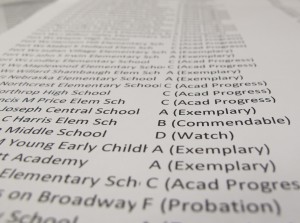Why The Release Of Indiana Schools' A-F Grades Has Been So Delayed

Photo Illustration by Kyle Stokes / StateImpact Indiana
Last year's school letter grades were released in August.
Last year, state education officials had published their letter grade ratings for every Indiana school by late August.
But as we creep into October — and as state officials work to implement an immensely-complicated new model for rating Indiana schools — this year’s release of state letter grades has been pushed back until October 31.
Indiana Department of Education spokesperson Stephanie Sample says state officials extended the period in which local district administrators can review their district’s preliminary results and, if they wish, appeal their letter grade.
“They want more time to examine their results and data, which is understandable,” Sample told StateImpact in an email.*
But the delays have provided a nit to pick for critics of state Superintendent Tony Bennett. Vic Smith, a retired educator and Indiana Coalition for Public Education board member, called the rollout of the new letter grades a “fiasco.”
In an email to supporters reposted at The Huntington Teacher, Smith chronicles what he lays out as a series of delays that speaks to — as he characterizes it — a bungled implementation of the state’s new A-F letter grades.
“While I did not expect the series of problems chronicled above, I did believe that the development of the system itself going back to 2010 was seriously flawed,” he wrote.
Jonathan Plucker, who directs IU’s Center for Evaluation and Education Policy, told StateImpact Friday he doesn’t see it that way:
I really think that the Department of Education wants to make sure that they are perfect, that there’s no mistakes. I really think [it’s] an appropriate level of caution. But people are getting really, really antsy. They need to come out soon, and it’s my understanding that they are going to.
From what I’ve heard through the grapevine, they’re checking, they’re rechecking, they’re making sure every bit of data — a ton of data has to go into this. They want to make sure everything is technically correct so we get kind of honest grades this first time around.
I think that’s really important because the intent as described to me at the very beginning of this process is this isn’t one of those systems we’re going to design and sit back for 5 to 10 years. They really want to tinker with it, make sure that it’s fair and accurate, that schools can move up through really good efforts. And so really they’re trying to be as careful as possible so we can improve this thing every single year. So I really think it’s an excess of caution at this point.
Plucker says he has seen the preliminary letter grades. He says the ratings will paint a positive picture of Indiana school performance.
Bennett has also said the grades will show which schools are promoting high student growth.
“We’re going to see both schools that have [a higher] percentage of disadvantaged students do better,” Bennett told StateImpact Thursday. “And we’re going to see a group of schools who believe they have always been successful by riding at or above that 90 percent who may not do as well as they thought.”
The new grading model has been the subject of much disagreement too — we cover the debate over whether the “Indiana growth model” works here and here.
UPDATE/CLARIFICATION: An earlier version of this post inaccurately inferred IDOE spokesperson Stephanie Sample believed the model is “complex.” She followed up with StateImpact by e-mail to say that isn’t quite the case:
The model is more comprehensive in that it considers more than just pass/fail like the old system. However, the data is clear and transparent. There are many pieces of local data, and schools are taking a harder closer look at those pieces than ever before. (We’re glad they’re paying closer attention.) If you have all the pieces that go into the calculation, the process is not complicated.


